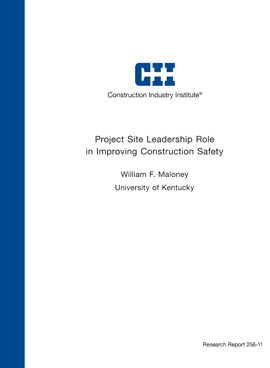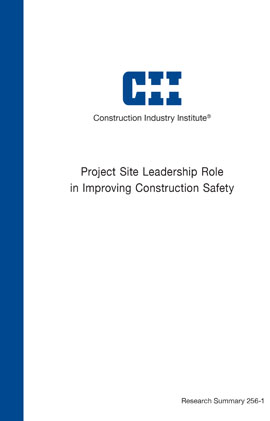
Project Site Leadership Role in Improving Construction Safety
The Construction Industry Institute established Research Team 256 during fall 2007 to examine the relationship between construction site leadership and safety performance. Robert Brooks of The Shaw Group and Rajinder Chopra of the Intel Corporation served as industry co-chairs while William Maloney of the University of Kentucky and Anthony Songer of Virginia Tech were the principal investigators. Ellie Rigbie of Virginia Tech served as graduate assistant to Professor Songer. Brian Kleiner of Virginia Tech joined the team after Dr. Songer’s departure from the team, and performed additional exploratory and confirmatory analyses.
Thirty-one projects participated in the study. A total of 3243 individuals participated including 456 individuals in leadership positions.
Using nine items from work by Zohar (2002), three safety values scales were identified: Injuries are preventable, Importance of an injury-free workplace, and Management Responsibility for a safe work place. Statistically significant differences were found based on age and position. The differences in mean scores for craft workers and supervisors were significant for all three safety value scales.
Five safety priority items (Zohar 2002) were used to assess leader priorities. Few of the differences in mean scores based upon age and position were significant and it was concluded that leader safety priorities were consistent across the project hierarchy.
The Leadership Practices Inventory (Kouzes and Posner 2003) was used to assess leader behaviors. It consists of 30 items constituting five scales: Challenge the Process, Inspire a Shared Vision, Enable Others to Act, and Model the Way, Encourage the Heart. Because the focus of the study was on safety, a six safety oriented items, which created a sixth scale, titled Promote Safety. The number of differences that were significant was minimal and it was concluded that leader behaviors were consistent across the project hierarchy.
Safety climate was assessed using 97 items drawn from Cooper (1993) and Geller. Principal components analysis identified six scales: Management Commitment, Individual Safety, Situational Awareness, Coworker Relationships, Supervisor Involvement in Safety, and Task Accomplishment. Significant differences were found between craft workers and supervisors on Management Commitment, Individual Safety, Coworker Relationships, and Task Accomplishment with supervisor scoring higher on Management Commitment and Coworker Prelateships and lower on Individual Safety and Task Accomplishment.
Safety performance was assessed using the Recordable Incidence Rate. The mean rate for the thirty-one projects was 2.04 with a standard deviation of 2.58. The distribution was heavily skewed to the left. Five of the projects reported a rate of 0.00.
Relationships between the factors in the model were assessed using correlation analysis. The correlations found between Safety Values and Safety Priorities are either not significant or weak Similar results were found for the relationships between Safety Values and Leader Behaviors and Safety Priorities and Leader Behaviors.
Significant and moderately strong relationships were found between leader behaviors and the safety climate scales.
Regression analysis was conducted to assess the relationship between leader behavior and the Recordable Incidence Rate. A two factor model was identified with Enable Others to Act and Model the Way as the leader behaviors with statistically significant coefficients.


